Structures Fort Mifflin | ||
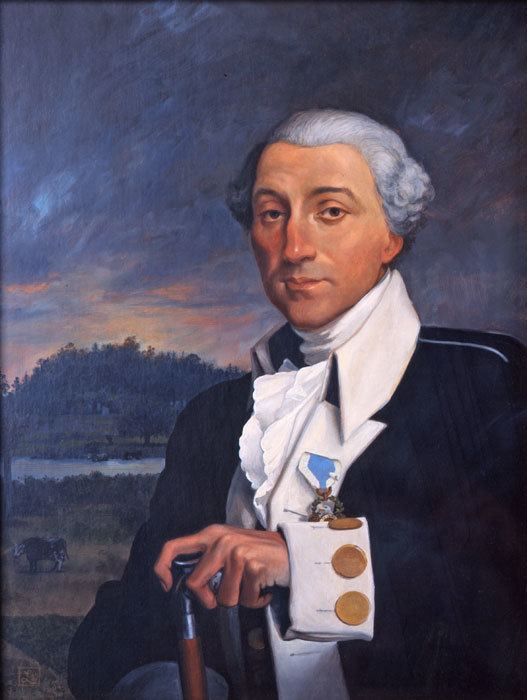 | ||
Nationality French (French-American) Occupation Architect, civil engineer, soldier Education Académie royale de peinture et de sculpture Books L'Enfant and Washington, 1791-1792 Similar | ||
Pierre "Peter" Charles L'Enfant ([pjɛʁ ʃɑʁl lɑ̃fɑ̃]; August 2, 1754 – June 14, 1825) was a French-born American architect and civil engineer best known for designing the layout of the streets of Washington, D.C., the L'Enfant Plan.
Contents
- Pierre charles l enfant
- Early life and education
- Military service
- PostRevolutionary War
- Plan for Federal City
- Later works
- Death
- Legacy
- Honors
- References
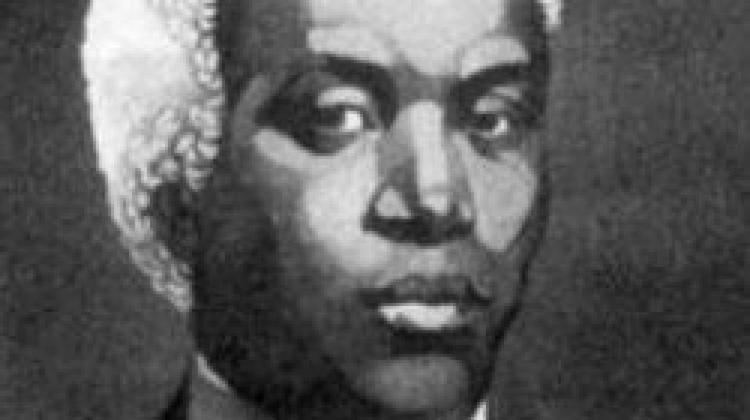
Pierre charles l enfant
Early life and education
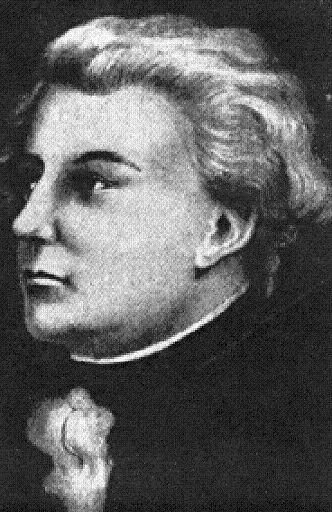
L'Enfant was born in Paris, France on August 2, 1754, the third child and second son of Pierre L'Enfant (1704–1787), a painter with a good reputation in the service of King Louis XV, and Marie Charlotte L'Enfant, the daughter of a minor official at court. In 1758, his brother Pierre Joseph died at the age of six, and Pierre Charles became the eldest son. He studied art at the Royal Academy in the Louvre, as well as with his father at the Royal Academy of Painting and Sculpture. He left school in France to enlist in the American Revolutionary War on the side of the rebelling colonials.
Military service

L'Enfant was recruited by Pierre Augustin Caron de Beaumarchais to join in the American Revolutionary War in the American colonies. He arrived in 1777 at the age of 23, and served as a military engineer in the Continental Army with Major General Lafayette. He was commissioned as a captain in the Corps of Engineers on April 3, 1779 to rank from February 18, 1778.
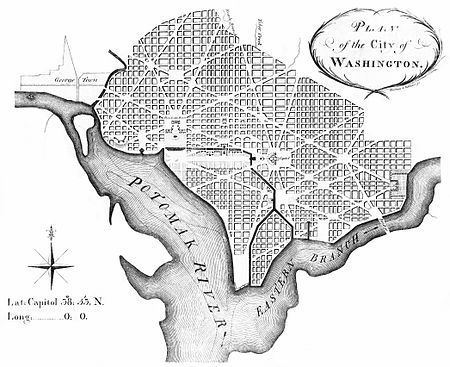
Despite his aristocratic origins, L'Enfant closely identified with the United States, changing his first name from Pierre to Peter. L'Enfant served on General George Washington's staff at Valley Forge. While there, the Marquis de Lafayette commissioned L'Enfant to paint a portrait of Washington.
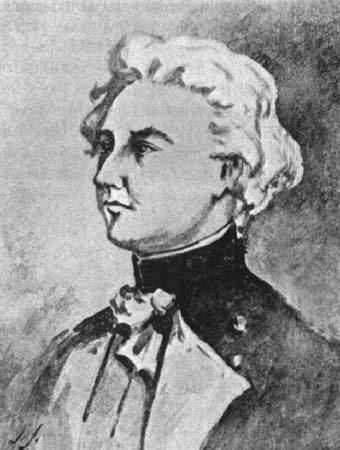
He was wounded at the Siege of Savannah on October 9, 1779. He recovered and became a prisoner of war at surrender of Charleston, South Carolina on May 12, 1780. He was exchanged in November 1780 and served on General George Washington's staff for the remainder of the Revolutionary War. L'Enfant was promoted by brevet to Major of Engineers on May 2, 1783, in recognition of his service to the cause of American liberty. He was discharged when the Continental Army was disbanded in December 1783.

After the war, L'Enfant designed the badge of the Society of the Cincinnati, an organization of former officers of the Continental Army, shaped as an eagle, at the request of Washington. He was sent to France to have insignias made for members of the Society, a group of veterans of the war.
Post–Revolutionary War

Following the American Revolutionary War, L'Enfant established a successful and highly profitable civil engineering firm in New York City. He achieved some fame as an architect by redesigning the City Hall in New York for the First Congress of the United States (See: Federal Hall). He also designed furniture and houses for the wealthy as well as coins and medals, including the insignia of the Society of the Cincinnati. He was also a friend of Alexander Hamilton.
While L'Enfant was in New York City, he was initiated into Freemasonry. His initiation took place on April 17, 1789, at Holland Lodge No. 8, F & A M, which the Grand Lodge of New York F & A M had chartered in 1787. L'Enfant took only the first of three degrees offered by the Lodge and did not progress further in Freemasonry.
Plan for Federal City
The new Constitution of the United States, which took effect in March and April 1789, gave the newly organized Congress of the United States authority to establish a federal district up to ten miles square in size. L'Enfant had already written to first President George Washington, asking to be commissioned to plan the city, but a decision on the capital was put on hold until July 1790 when the First Congress passed the "Residence Act", setting the site of the new federal district and national capital to be on the shores of the Potomac River.
The Residence Act was the result of an important early political compromise between northern and southern congressional delegations, brokered by new cabinet members, Secretary of the Treasury, Alexander Hamilton of New York and political opponent, Secretary of State Thomas Jefferson, of Virginia. It specified the new capital would be situated on the northern and southern banks of the Potomac River, at some location, to be determined by the president, between the Eastern Branch (now referred to as the Anacostia River) near Washington's estate of Mount Vernon and the confluence with the Conococheague Creek, further upstream near Hagerstown, Maryland. The Residence Act also gave authority to President Washington to appoint three commissioners to oversee the survey of the ten mile square federal district and "according to such Plans, as the President shall approve," provide public buildings to accommodate the Federal government in 1800.
President Washington appointed L'Enfant in 1791 to plan the new "Federal City" (later named the "City of Washington") under the supervision of three Commissioners, whom Washington had appointed to oversee the planning and development of the federal territory that would later become designated the "District of Columbia". Included in the new district were the river port towns of Georgetown (formerly in Montgomery County of the State of Maryland) and Alexandria (in Fairfax County, in the Commonwealth of Virginia). Thomas Jefferson, who worked alongside President Washington in overseeing the plans for the capital, sent L'Enfant a letter outlining his task, which was to provide a drawing of suitable sites for the federal city and the public buildings. Though Jefferson had modest ideas for the Capital, L'Enfant saw the task as far more grandiose, believing he was not only locating the capital, but also devising the city plan and designing the buildings.
L'Enfant arrived in Georgetown on March 9, 1791, and began his work, from Suter's Fountain Inn. Washington arrived later on March 28, to meet with L'Enfant and the Commissioners for several days. On June 22, L'Enfant presented his first plan for the federal city to the President. On August 19, he appended a new map to a letter that he sent to the President.
President Washington retained a copy of one of L'Enfant's plans, showed it to the Congress, and later gave it to the three Commissioners. The U.S. Library of Congress now holds both the plan that Washington apparently gave to the Commissioners and an undated anonymous survey map that the Library considers L'Enfant to have drawn before August 19, 1791.
The full plan identifies "Peter Charles L'Enfant" as its author in the last line of an oval in its upper left corner. The survey map may be one that L'Enfant appended to his August 19 letter to the President.
L'Enfant's "Plan of the city intended for the permanent seat of the government of the United States..." encompassed an area bounded by the Potomac River, the Eastern Branch, the base of the escarpment of the Atlantic Seaboard Fall Line, and Rock Creek. His plan specified locations for two buildings, the "Congress House" (the United States Capitol) and the "President's House" (known after its 1815–1817 rebuilding and white-washing of its stone walls, as the "White House" or "Executive Mansion").
The "Congress House" would be built on "Jenkins Hill" (later to be known as "Capitol Hill"), which L'Enfant described as a "pedestal awaiting a monument". The "President's House" would be located at a northwest diagonal from the "Congress House" along the future Pennsylvania Avenue. The "President's House" would be situated on a ridge parallel to the Potomac River, north of a riverfront marsh and a canal (known as "Tiber Canal" or the "Washington City Canal" during the 1800s).
L'Enfant envisioned the "President's House" to have public gardens and monumental architecture. Reflecting his grandiose visions, he specified that the "President's House" (occasionally referred to as the "President's Palace") would be five times the size of the building that was actually constructed, even then becoming the largest residence then constructed in America. Emphasizing the importance of the new Nation's Legislature, the "Congress House" would be located on a longitude designated as 0:0.
The plan specified that most streets would be laid out in a grid. To form the grid, some streets (later named for letters of the alphabet) would travel in an east-west direction, while others (named for numbers) would travel in a north-south direction. Diagonal broader avenues, later named after the states of the Union, crossed the north/south-east/west grid. The diagonal avenues intersected with the north-south and east-west streets at circles and rectangular plazas that would later honor notable Americans and provide open space.
L'Enfant laid out a 400 feet (122 m)-wide garden-lined "grand avenue", which he expected to travel for about 1 mile (1.6 km) along an east-west axis in the center of an area that would later become the National Mall. He also laid out a narrower avenue (Pennsylvania Avenue) which would connect the "Congress House" with the "President's House". In time, Pennsylvania Avenue developed into the capital city's present "grand avenue".
L'Enfant's plan additionally laid out a system of canals (later designated as the Washington City Canal) that would pass the "Congress House" and the "President's House". One branch of the canal would empty into the Potomac River south of the "President's House" at the mouth of old Tiber Creek, which would be channelized and straightened.
L'Enfant secured the lease of quarries at Wigginton Island and further southeast along Aquia Creek off the lower Potomac River southern bank in Virginia to supply well-regarded "Aquia Creek sandstone" for the foundation and later for the wall slabs and blocks of the "Congress House" in November 1791. However, his temperament and his insistence that his city design be realized as a whole, brought him into conflict with the Commissioners, who wanted to direct the limited funds available into construction of the Federal buildings. In this, they had the support of Secretary of State Thomas Jefferson.
During a contentious period in February 1792, Andrew Ellicott, who had been conducting the original boundary survey of the future District of Columbia (see: Boundary Stones (District of Columbia)) and the survey of the "Federal City" under the direction of the Commissioners, informed the Commissioners that L'Enfant had not been able to have the city plan engraved and had refused to provide him with the original plan (of which L'Enfant had prepared several versions). Ellicott, with the aid of his brother, Benjamin Ellicott, then revised the plan, despite L'Enfant's protests. Ellicott's revisions, which included the straightening of the longer avenues and the removal of L'Enfant's Square No. 15, created changes to the city's layout (See: Randolph Square).
Andrew Ellicott stated in his letters that, although he was refused the original plan, he was familiar with L'Enfant's system and had many notes of the surveys that he had made himself. It is therefore possible that Ellicott recreated the plan.
Shortly thereafter, Washington dismissed L'Enfant. After L'Enfant departed, Andrew Ellicott continued the city survey in accordance with the revised plan, several versions of which were engraved, published and distributed. As a result, Ellicott's revisions subsequently became the basis for the capital city's development.
The work of André Le Nôtre, particularly his Gardens of Versailles, is said to have influenced L'Enfant’s master plan for the capital.
Later works
Soon after leaving the national capital area, L'Enfant prepared the initial plans for the city of Paterson, in northeast New Jersey along the Passaic River, but was discharged from this project after a year had passed. However, in 1846 the city reinstated the original scheme proposed by L'Enfant after the city's raceway system encountered problems. During the same period (1792–1793) he designed Robert Morris' mansion in Philadelphia, which was never finished because of his delays and Morris' bankruptcy.
In 1812, he was offered a position as a professor of engineering at United States Military Academy, at West Point, New York, but declined that post. He later served as a professor of engineering at West Point from 1813 to 1817. In 1814, L'Enfant worked briefly on the construction of Fort Washington on the Potomac River southeast of Washington, D.C., but others soon replaced him.
Contrary to numerous Internet postings, L'Enfant did not survey and plat Perrysburg, Ohio on April 26, 1816; this survey was performed by surveyors Joseph Wampler and William Brookfield under the auspices of Josiah Meigs, surveyor general of Ohio, Michigan, Indiana, Illinois and Missouri. Washington is the only city that he designed; a protege designed Indianapolis.
Death
L'Enfant died in poverty, June 14, 1825. He was originally buried at the Green Hill farm in Chillum, Prince George's County, Maryland. He left behind three watches, three compasses, some books, some maps, and surveying instruments, whose total value was about forty-five dollars.
Legacy
In 1901 and 1902, the McMillan Commission under the leadership of Senator James McMillan, (1838–1902), of Michigan, modified L'Enfant's plan within a report that recommended a partial redesign of the capital city. Among other things, the Commission's report laid out a plan for a sweeping mall in the area of L'Enfant's widest "grand avenue", which had not yet been constructed. The McMillan Plan has since been instrumental in the further development of Washington, D.C. (See: History of Washington, D.C. in the 20th century).
At the instigation of a French Ambassador to the United States, Jean Jules Jusserand, L'Enfant's adopted nation then recognized his contributions. In 1909, L'Enfant's remains were exhumed from their burial site at Green Hill and placed in a metal-lined casket. After lying in state at the Capitol rotunda, L'Enfant was re-interred in front of Arlington House on a slope in Arlington National Cemetery in Virginia. His re-burial site overlooks the Potomac River and the portion of Washington, D.C., that he had originally designed.
In 1911, a monument was placed on top of L'Enfant's grave during a dedication ceremony at which President William Howard Taft, Jusserand and Senator Elihu Root spoke. Engraved on the monument is a portion of L'Enfant's own plan in a diagram map, which Andrew Ellicott's revision and the McMillan Commission's plan had superseded.
